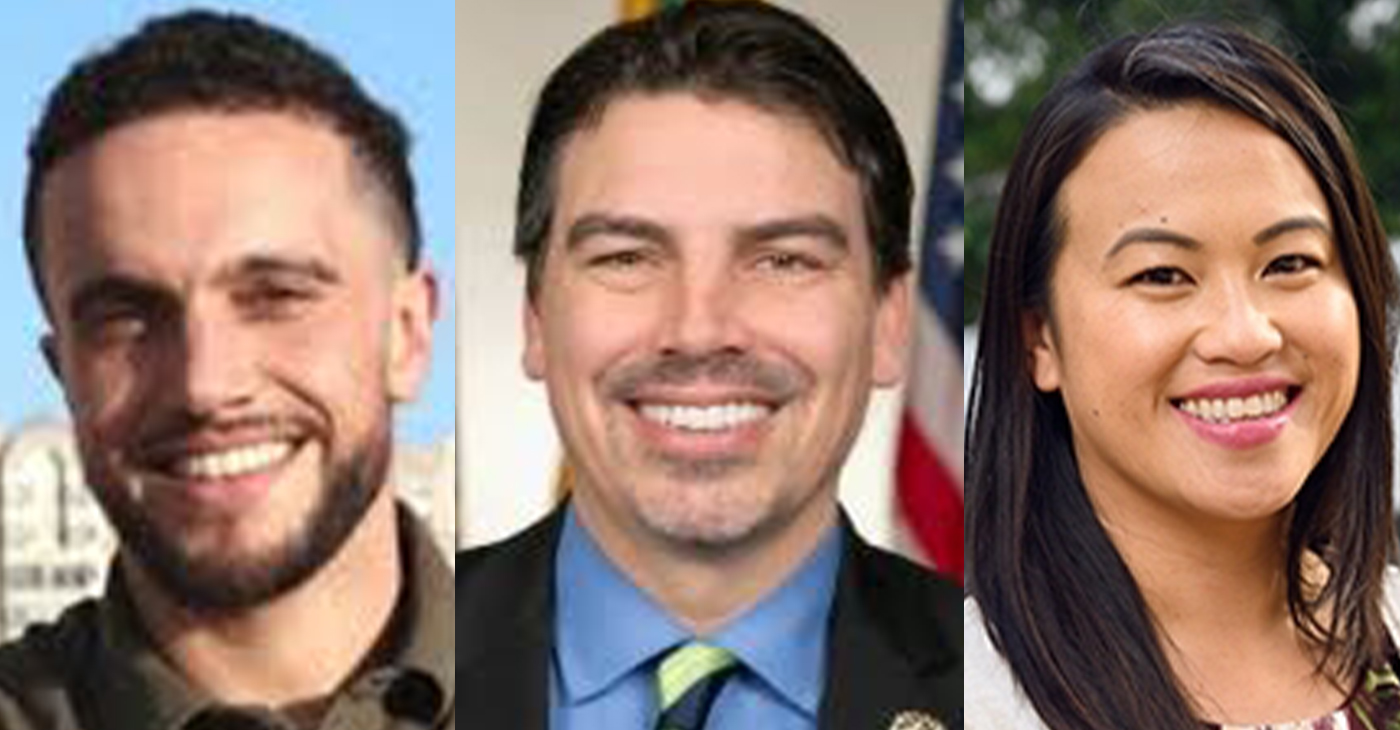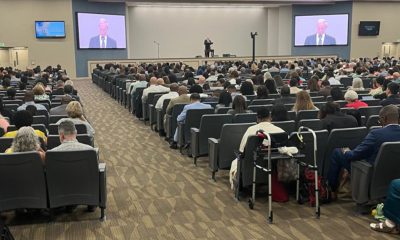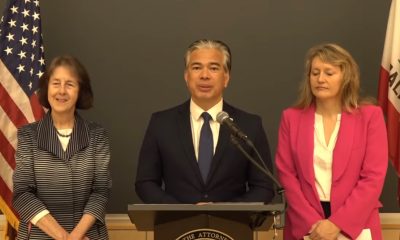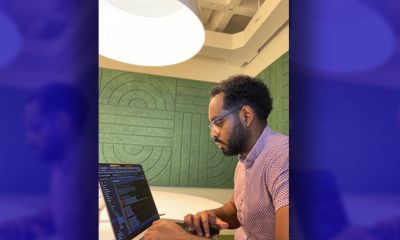Technology
Are You Willing to Pay to Watch Video Clips Online?

In this photo taken Monday, March 23, 2015, Vessel CEO and co-founder Jason Kilar, left, and co-founder Richard Tom pose for a photo at their headquarters in San Francisco. (AP Photo/Eric Risberg)
MICHAEL LIEDTKE, AP Technology Writer
SAN FRANCISCO (AP) — Would you pay to see some of the Internet’s best video clips first? Vessel, a new service trying to change the way that short video pieces make money on the Internet and mobile devices, is betting on it.
Instead of free-for-all distribution supported solely by advertising, Vessel will charge $3 per month for exclusive early access to clips of musicians, sporting events, comedians and many other forms of entertainment not available on YouTube or any other digital video service for at least three days. CEO Jason Kilar, formerly head of Hulu Plus, believes Vessel’s model will be able to pay video producers about $50 per 1,000 views of their clips on the site. That compares with just $2.20 per 1,000 views of ad-supported video at sites such as YouTube, Kilar says.
The extra money, in theory, will provide digital video producers with the means and incentive to create even better content that will prod more people to subscribe to Vessel. The same “virtuous cycle” has enabled Internet video service Netflix to finance more of its own original programming and pay more money to license compelling entertainment while its audience has nearly tripled to 57 million customers from 20 million in the past four years.
“We think this is going to be a really big deal, like the advent of cable-and-satellite television in the 1970s,” Kilar, 43, says of Vessel.
YouTube, which is owned by Google Inc., says Kilar’s estimates are wrong, but declined to reveal its average payout per 1,000 views. Payments to YouTube partners have increased by at least 50 percent in each of the past three years, the company says. Research firm eMarketer Inc. estimated that YouTube’s total ad revenue last totaled $7.6 billion and about $4.6 billion was paid out to YouTube’s partners.
The concept, which has been in beta testing for two months, debuts Tuesday. Anyone who signs up with Vessel by 3 a.m. EDT Friday will receive a one-year subscription for free.
Vessel’s ambitions sound like wishful thinking to Forrester Research analyst Jim Nail, who doubts many people will pay to watch a video that will be available for free within a few days.
“That kind of restriction only works when you have content that people are really knocking down the doors to see,” Nail says. “It is going to totally come down to what kind of content that they can get. Unless they have the content that justifies paying $3 a month, nothing will save them.”
Vessel so far has about 70,000 video clips separated into about 160 categories, including sports, comedy, music, video games and food. Many clips are free and supported by ads, just like most video on YouTube. Vessel’s subscription side features videos from about 130 contributors. They include Emmy Award-winning actor Alec Baldwin, who is showcasing “Love Ride,” a series featuring him dispensing relationship advice in the back seat of taxis, and the online comedy duo of Rhett McLaughlin and Link Neal, who have more than 3 million subscribers on their YouTube channel.
Machinima CEO Chad Gutstein anticipates a large audience will pay for early access to the video gaming specialist’s clips because video game enthusiasts “are more engaged and more obsessed with what they are doing than anything I have ever experienced. They just want to be there first.”
Before Vessel, Kilar spent five years running online television streaming service Hulu, which was launched in 2007 by a group of TV networks trying to counter YouTube’s popularity. By the time Kilar stepped down in 2013, Hulu’s premium Plus service had attracted about 6 million subscribers, though it never mounted much of a challenge to YouTube, where about 300 hours of video is posted per minute.
Since Kilar and another former Hulu executive Rich Tom started Vessel last year, the San Francisco startup has raised $77 million from two venture capital firms, Greylock Partners and Benchmark Capital, and Amazon.com Inc. CEO Jeff Bezos.
Copyright 2015 The Associated Press. All rights reserved. This material may not be published, broadcast, rewritten or redistributed.
Alameda County
Oakland Awarded $15 Million by CPUC to Expand Broadband Access
The California Public Utilities Commission (CPUC) has awarded the City of Oakland $15 million as part of the $2 billion Last Mile Federal Funding Account Grant Program. This significant investment aims to enhance broadband access for underserved and unserved communities across Oakland, bringing the city one step closer to achieving digital equity.

Courtesy of the Mayor’s Press Office
The California Public Utilities Commission (CPUC) has awarded the City of Oakland $15 million as part of the $2 billion Last Mile Federal Funding Account Grant Program.
This significant investment aims to enhance broadband access for underserved and unserved communities across Oakland, bringing the city one step closer to achieving digital equity.
Mayor Sheng Thao expressed her gratitude for the grant, emphasizing the collaborative efforts that led to this achievement.
“This award is a testament to the hard work and dedication of our team and partners. I want to extend my heartfelt thanks to the CPUC for their investment in Oakland.
“I also want to recognize Tony Batalla, our chief information officer, for his leadership and Patrick Messac from OaklandUndivided for his relentless commitment to bridging the digital divide,” said Thao. “Last Fall, I hosted a meeting in my office with the CPUC, City, and community partners to discuss our vision for a more connected Oakland. This grant is a significant milestone in making that vision a reality.”
Batalla stated, “I am extremely proud of the team that worked on this. I also want to thank the CPUC for selecting our project and providing this incredible opportunity to invest in underserved communities in Oakland.”
Patrick Messac, director of OaklandUndivided, added, “This represents the culmination of years of collaboration between the City of Oakland, Oakland Unified School District, Oakland Housing Authority, and many trusted community partners. The Oakland Connect project will promote a more connected and more equitable Oakland.”
The CPUC’s Last Mile Federal Funding Account Grant Program is a crucial component of California’s Broadband For All initiative, which aims to provide high-speed internet access to all Californians.
The program’s first round of awards, totaling $88.6 million, will fund projects that build community-based, future-proof, and equity-focused broadband infrastructure across the state.
For more information about the CPUC’s Federal Funding Account Recommendations and Awards, please visit their webpage.
#NNPA BlackPress
360 Video 2024 Genesis G70 AWD 3.3T Sport Prestige
360 Video 2024 Genesis G70 AWD 3.3T Sport Prestige interior, exterior walkaround. You select the POV. View our best-detailed walkaround videos most with POV drives, walkthroughs, and 360 videos of the most sought-after new cars, trucks, SUVs, crossovers, Vans, and Minivans with/ detailed walkarounds of special models in their entirety at full screen. Our videos […]
The post 360 Video 2024 Genesis G70 AWD 3.3T Sport Prestige first appeared on BlackPressUSA.

360 Video 2024 Genesis G70 AWD 3.3T Sport Prestige interior, exterior walkaround. You select the POV.
View our best-detailed walkaround videos most with POV drives, walkthroughs, and 360 videos of the most sought-after new cars, trucks, SUVs, crossovers, Vans, and Minivans with/ detailed walkarounds of special models in their entirety at full screen.
Our videos allow the autos to speak for themselves with minimal distractions from human voice-overs. Just natural sounds and great footage just for you.
Unique to AutoNetwork.com.
{Introducing our new car buying program, https://www.CouponsOffersAndDeals.com/, for money and time-saving specials from select car dealers.}
Like us and share, https://www.facebook.com/autonetwork, on Facebook.
#autonetwork #autonetworkreports
[Subscribe to our channel now for more videos] https://www.youtube.com/channel/UCuN8D-xz08dJGWXVDMEIA1A
** Twitter http://www.twitter.com/liveautos
** LinkedIn http://www.linkedin.com/in/autonetwork
#newcar #africanamericancarreviewer #autoservicecoupons #carreviewnew #newcarreviews #carreviews2024 #carreviewswebsites #usauto #autonetwork #autonetwork.com #360degreecar #newcarcompany #newcarcompanies #povtestdrive #carreviews #carreviewswebsites #youtubecarreviews #bestcarreviews #electriccarreviews2024 #AutoNetwork #AutoNetworkReports #AutoTalkShow #bestdetailedwalkaround
The post 360 Video 2024 Genesis G70 AWD 3.3T Sport Prestige first appeared on BlackPressUSA.
#NNPA BlackPress
A Sports Car in Sedan Clothing 2024 Genesis G70 AWD 3.3T Sport Prestige
2024 Genesis G70 AWD 3.3T Sport Prestige Imagine a car that not only turns heads with its sleek design but also promises an exhilarating sports car drive every time you press the gas pedal. Enter the 2024 Genesis G70 AWD 3.3T Sport Prestige, a luxury sports sedan that blends style, performance, and cutting-edge technology to […]
The post A Sports Car in Sedan Clothing 2024 Genesis G70 AWD 3.3T Sport Prestige first appeared on BlackPressUSA.

2024 Genesis G70 AWD 3.3T Sport Prestige
Imagine a car that not only turns heads with its sleek design but also promises an exhilarating sports car drive every time you press the gas pedal. Enter the 2024 Genesis G70 AWD 3.3T Sport Prestige, a luxury sports sedan that blends style, performance, and cutting-edge technology to create an unforgettable driving experience. Let’s delve into why this car should be at the top of your list for a test drive.
Starting with the heart of the Genesis G70, the 3.3L Twin Turbo V6 engine delivers a robust 365 horsepower and 376 lb-ft of torque, making it a powerhouse ready to tackle the open road. The 8-speed automatic transmission ensures smooth shifting and responsiveness, enhancing the sporty feel of the drive. The inclusion of an electronically controlled suspension and a limited-slip differential in the Sport Prestige package further elevates the handling, allowing for sharp, precise control that rivals the agility of dedicated sports cars.
Aesthetics are as important as performance the Genesis G70 doesn’t disappoint. Dressed in a striking Bond Silver exterior featuring a sophisticated Fog Gray two-tone interior, the car exudes luxury from every angle. The 19-inch sport alloy wheels, dark chrome grille, and daylight opening trim add to its dynamic appearance, ensuring you’ll stand out in any crowd.
The G70’s cabin is a haven of advanced features and comfort. Nappa leather seating surfaces, a microfiber suede headliner, and a range of adjustment options in the power front seats—including a driver’s seat bolster and cushion extension—ensure utmost comfort, even on longer journeys. The ventilated front seats and heated steering wheel offer an extra layer of luxury that makes driving in any weather a pleasure.
On the tech front, the Genesis G70 is equally impressive. The 10.25″ navigation system integrates seamlessly with Apple CarPlay® and Android Auto , making connectivity a breeze. For audiophiles, the Lexicon® premium audio system delivers crystal-clear sound, transforming your car into a concert hall. Safety is paramount, and the G70 comes equipped with an array of advanced safety technologies such as Forward Collision-Avoidance Assist, Lane Keeping Assist, and a Blind-Spot View Monitor, all designed to keep you safe on the road.
, making connectivity a breeze. For audiophiles, the Lexicon® premium audio system delivers crystal-clear sound, transforming your car into a concert hall. Safety is paramount, and the G70 comes equipped with an array of advanced safety technologies such as Forward Collision-Avoidance Assist, Lane Keeping Assist, and a Blind-Spot View Monitor, all designed to keep you safe on the road.
Now, consider the practical everyday features that enhance convenience and usability. The hands-free smart trunk with auto open adds a touch of practicality, perfect for when your hands are full. The inclusion of a wireless phone charger and Genesis Digital Key highlight the G70’s commitment to modern, hassle-free living.
While the back seat might be a tad cramped, the G70’s exhilarating performance and luxury features far outweigh this minor con. From the driver’s seat side bolsters that tighten in Sports Mode to the multiple driving modes that cater to your mood and the road conditions, every element is designed to enhance your driving pleasure.
To sum up, the 2024 Genesis G70 AWD 3.3T Sport Prestige is not just a car; it’s a statement. It promises not only a thrilling ride but also a sanctuary of advanced technology and luxurious comfort. Why not experience this blend of art and engineering for yourself? Take it for a test drive and let the car speak for itself.
Unique to AutoNetwork.com.
Enjoy and please comment on our detailed walkaround videos. Most will have a POV test drive. We have a video library of 360 videos of the most sought-after new cars, trucks, SUVs, crossovers, Vans, and Minivans. Minimal distractions from voice-overs. Just natural sounds and great footage just for you. Please like, Subscribe, and comment.
https://www.CouponsOffersAndDeals.com
Like us and share, https://www.facebook.com/autonetwork, on Facebook.
#autonetwork #autonetworkreports
[Subscribe to our channel now for more videos] https://www.youtube.com/channel/UCuN8D-xz08dJGWXVDMEIA1A
** Twitter http://www.twitter.com/liveautos
** LinkedIn http://www.linkedin.com/in/autonetwork
#newcar #africanamericancarreviewer #autoservicecoupons #carreviewnew #newcarreviews #carreviews2024 #carreviewswebsites #usauto #autonetwork #autonetwork.com #360degreecar #newcarcompany #newcarcompanies #povtestdrive #carreviews #carreviewswebsites #youtubecarreviews #bestcarreviews #electriccarreviews2024 #AutoNetwork #AutoNetworkReports #AutoTalkShow #bestdetailedwalkaround
The post A Sports Car in Sedan Clothing 2024 Genesis G70 AWD 3.3T Sport Prestige first appeared on BlackPressUSA.
-

 Arts and Culture3 weeks ago
Arts and Culture3 weeks agoRooted in Tradition: The Intricate History of Black Hair Braiding
-

 Bay Area4 weeks ago
Bay Area4 weeks ago“I Will Not Be Bullied,” Says Oakland Mayor Sheng Thao
-

 Bay Area2 weeks ago
Bay Area2 weeks agoPG&E Increases Rates While Bay Area Households Are Struggling to Stay Afloat
-

 Business3 weeks ago
Business3 weeks agoGov Newsom: Raising Fast Food Minimum Wage to $20 Pays Off as Jobs Multiply in Industry
-

 Activism4 weeks ago
Activism4 weeks agoOpponents of Mayor Sheng Thao Are Calling on Her to Resign Following FBI Raid
-

 Community1 week ago
Community1 week agoHundreds Come to Jehovah’s Witnesses’ Assembly Hall for Three-Day Program of ‘Good News’ in Fremont
-

 Bay Area2 weeks ago
Bay Area2 weeks agoJuneteenth Mass Shooting Suspect Charge with Multiple Counts of Felony Assault by Alameda County DA Pamela Price
-

 Activism4 weeks ago
Activism4 weeks agoOakland Coliseum Sale to AASEG: A Model for Community Development and Inclusion




















































